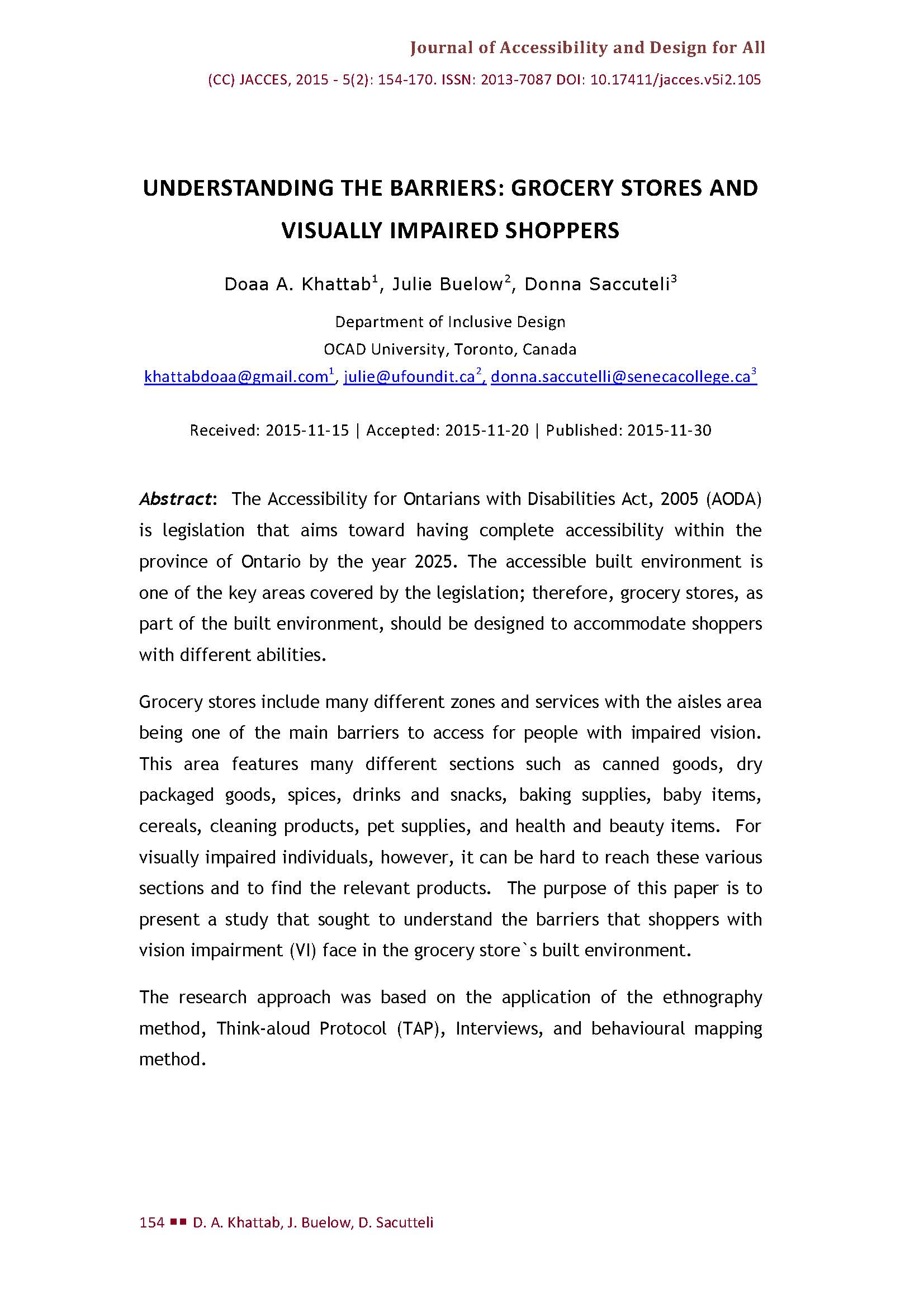UNDERSTANDING THE BARRIERS: GROCERY STORES AND VISUALLY IMPAIRED SHOPPERS
DOI:
https://doi.org/10.17411/jacces.v5i2.105Keywords:
Grocery store, Wayfinding, visually impaired shoppers, vision impairment, accessibility, inclusive design, and sensory environmentAbstract
The Accessibility for Ontarians with Disabilities Act, 2005 (AODA) is legislation that aims toward having complete accessibility within the province of Ontario by the year 2025. The accessible built environment is one of the key areas covered by the legislation; therefore, grocery stores, as part of the built environment, should be designed to accommodate shoppers with different abilities.
Grocery stores include many different zones and services with the aisles area being one of the main barriers to access for people with impaired vision. This area features many different sections such as canned goods, dry packaged goods, spices, drinks and snacks, baking supplies, baby items, cereals, cleaning products, pet supplies, and health and beauty items. For visually impaired individuals, however, it can be hard to reach these various sections and to find the relevant products. The purpose of this paper is to present a study that sought to understand the barriers that shoppers with vision impairment (VI) face in the grocery store`s built environment.
The research approach was based on the application of the ethnography method, Think-aloud Protocol (TAP), Interviews, and behavioural mapping method.
References
. Chapman, B. (2001). Major causes of vision loss. In B. Chapman (ed.), Coping with Vision Loss (p. 282). California: Hunter House
. Catteneo, Z., & Vecchi, T. (2011). Blurred vision. In Z. Catteneo & T. Vecchi (Eds.), Blind Vision (pp. 11–12). Cambridge, MA: The MIT Press. Retrieved August 2014.
. Hoey, B. (2013). What is ethnography? Retrieved November 2013 from http://www.brianhoey.com/General%20Site/general_defn-ethnography.htm.
. Hanington, B., & Martin, B. (2012). Universal methods of design: 100 ways to research complex problems, develop innovative ideas, and design effective solutions. Minneapolis, MN: Rockport Publishers.
. Ohta, M. & Higuchi, Y. (2013). Study on the design of supermarket store layouts: the principle of “sales magnet”. Retrieved from http://waset.org/publications/2256/study-on-the-design-of-supermarket-store-layouts-the-principle-of-sales-magnet-
. RNIB (n.d.). Good practice guide: the retail experience. Navigating and locating. Retrieved from http://www.ncbi.ie/information-for/best-practice-guides/good-practice-guide-the-retail-experience.
. RNIB (n.d.). Good practice guide: the retail experience. Customer care. Retrieved from http://www.ncbi.ie/information-for/best-practice-guides/good-practice-guide-the-retail-experience.
. RNIB (n.d.). Good practice guide: the retail experience. The costly truth. Retrieved from http://www.ncbi.ie/information-for/best-practice-guides/good-practice-guide-the-retail-experience.
. RNIB (n.d.). Good practice guide: the retail experience. Paying for goods. Retrieved from http://www.ncbi.ie/information-for/best-practice-guides/good-practice-guide-the-retail-experience.

Downloads
Published
Issue
Section
License
- Authors retain copyright and grant the journal right of first publication with the work simultaneously licensed under a Creative Commons Attribution License that allows others to share or adapt the work with an acknowledgment of the work's authorship and initial publication in this journal. Use of the work for commercial purposes are not allowed.
- Authors are able to publish the journal's published version of the work in other media (e.g., post it to an institutional repository or publish it in a book), as far as they inform the Journal of Accessibility and Design for All of that fact. When publishing their work in other sources, authors must mention the name of the Journal of Accessibility and Design for All, its ISSN, the number and issue in which the article was published and a link to the main page of the Journal of Accessibility and Design for All. Optionally, they can also include a link to the article published in the Journal of Accessibility and Design for All.
- Authors are permitted and encouraged to post their work online (e.g., in institutional repositories or on their website), as it can lead to productive exchanges, as well as earlier and greater citation of published work.

